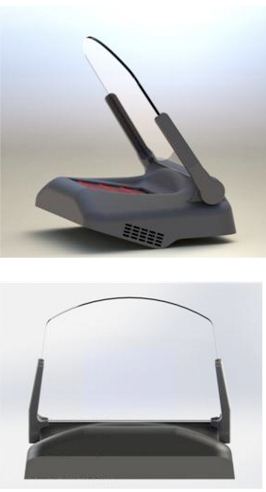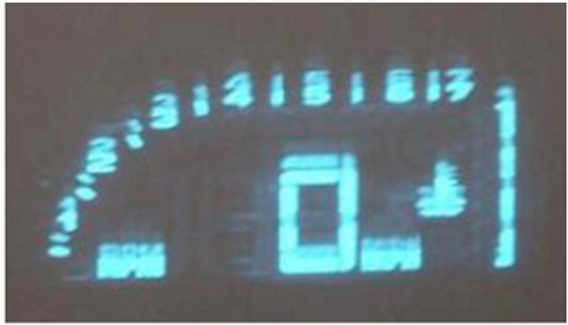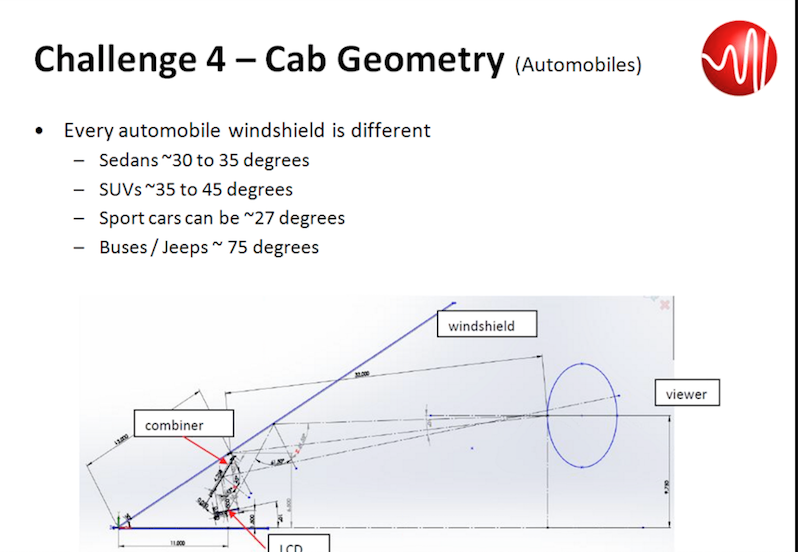Flat panel LCD and OLED’s aren’t the only displays looking to the automotive market for sustainable growth. A new aftermarket HUD system is proposed by Seattle based Lightspeed Interface, with details presented to the Pacific Northwest chapter in Seattle on November 30, by company founder and chief technology officer Barton Jenson. Here is the scoop.
Jenson’s talk focused on the needs challenges and future success factors in developing an aftermarket head up display (HUD) targeting cars already in the market. The review included details on a soon to be released product from Litespeed called Lumidrive that will be used on road vehicles with critical (but not too much) augmented information for the driver, in both daylight and night driving conditions.  Lumidrive aftermarket HUD from Lightspeed uses combiner display to upgrade most cars augmented driving experience. Source: Company
Lumidrive aftermarket HUD from Lightspeed uses combiner display to upgrade most cars augmented driving experience. Source: Company
Lumidrive is a transparent (what they call “additive”) display that superimposes images on to the natural world of the driver’s field of vision with “conformal symbology” that augments reality in a meaningful way.
Key components of the system include a light engine, display, imaging optics and (for this product) an all important optical combiner that is partly reflective, yet must remain highly transparent, to allow for superimposed virtual images onto the driver’s field of view.
A major challenge facing the development team was the broad operating range in luminance that ranges from full on sunlight (about (10K nits) or even higher sunlit snow (34K cd/m²) to absolute dark, moonless night (0.1 cd/m²). “We’re talking about developing a light engine that can compete with bright daylight in the range of a 50K nit projector that will lose up to 80% light. It must also offer a wide dimming range for night time viewing with a range of about 4000x,” according to Jensen. A table of the various ambient light conditions is provided here.

Contrast is the key
it’s the additive display nature of the HUD which is in competition with background light (especially daylight) that makes contrast so important. Lightspeed used a formula to calculate the luminance requirements of its aftermarket HUD system reckoning a 1.3:1 contrast for typical applications would require a display luminance at night of just 0.15 cd/m² and luminance against white snow backgrounds would need to reach over 10,200 cd/m². That makes for a whopping dimming range of 10,200 / 0.15.
Other challenges included the combiner design requirements which needs transparency and efficient light reflection. Key to the viewability of the combiner is the suppression of optical interference to eliminate what the company characterizes as ghosting. Make no mistake it’s getting the combiner technology right that is the lynch pin of the system for after market HUDs. Unlike expensive custom built-in systems, Lumidrive cannot depend on custom optics made to fit the geometries of each model’s unique windscreen requirement. In fact this is the gating issue that keeps OEM HUD system costs rather high, as the car maker cannot leverage total sales volume (unlike other components, radio, HVAC systems etc.) due to each car model’s unique windscreen requirements.
 Corvette HUD systen installed using non-HUD windscreen with double imageTo emphasize the point, Jenson showed an image of a factory installed Corvette HUD system that was lifted out of the original car, and installed into the same model without the HUD from the factory. That system exhibits the ghosting (double image) issue due to the air gap in the non-HUD installed windscreen from the reflection from each glass-air interface.
Corvette HUD systen installed using non-HUD windscreen with double imageTo emphasize the point, Jenson showed an image of a factory installed Corvette HUD system that was lifted out of the original car, and installed into the same model without the HUD from the factory. That system exhibits the ghosting (double image) issue due to the air gap in the non-HUD installed windscreen from the reflection from each glass-air interface.
It turns out that Chevrolet installs a special (no air gap) windscreen on all HUD models it ships. (see image.) In short the windscreen exhibits multiple Fresnel refractions.
 Since windscreens differ from vehicle to vehicle making economies of scale for HUD systems difficult and pushing after market providers to look for combiner display solutions like the one from Lightspeed Jenson posed the question: “if even upgrading an existing non-HUD car with the standard equipment from one of the same model is no guarantee it will work, how hard must it be to develop an after-market HUD system to fit most all vehicles?” The solution required unique imaging optics packaging that must deal with a variety of cab (car, truck even specialty vehicles like bus and tractor) geometries and the combiner gets the job done.
Since windscreens differ from vehicle to vehicle making economies of scale for HUD systems difficult and pushing after market providers to look for combiner display solutions like the one from Lightspeed Jenson posed the question: “if even upgrading an existing non-HUD car with the standard equipment from one of the same model is no guarantee it will work, how hard must it be to develop an after-market HUD system to fit most all vehicles?” The solution required unique imaging optics packaging that must deal with a variety of cab (car, truck even specialty vehicles like bus and tractor) geometries and the combiner gets the job done.
To get there, Jenson told us that the group developed a unique wedge design combiner system that includes much of the ‘secret sauce’ in their solution and resulted in multiple patent filings that should give the company an edge in the aftermarket HUD space.
All in, the talk revealed the remarkable engineering and creative thinking that went into tackling the multiple challenges of bringing the Lightspeed Lumidrive to market. We see the Lumidrive as a leap forward, offering an augment reality display that can provide drivers a safe and non-distracting solution to viewing critical information while keeping eyes safely on the road. – Steven Sechrist

